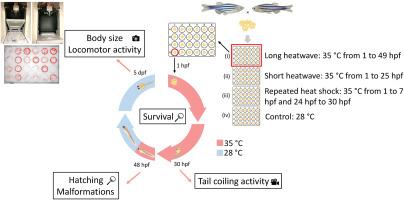Heatwaves during embryonic development reveal duration-dependent effects in zebrafish
IF 2.9
2区 生物学
Q2 BIOLOGY
引用次数: 0
Abstract
Heatwaves, defined as periods of unusually high temperatures are increasingly frequent due to climate change. It is well known that ectotherms are particularly vulnerable to heat stress, especially during sensitive life stages such as embryonic development. However, the consequences of short, ecologically relevant heat stress, remain less investigated. Here, we investigate the effects of short-term heat stress during embryonic development in zebrafish (Danio rerio). For this, 1753 embryos were exposed to simulated heatwaves of different durations (6, 24, or 48 h) and frequencies (one or two events) during development, with a temperature of 35 °C (+7 °C above the standard temperature of 28 °C). Their pre- and post-natal survival, hatching time, larval body size, and locomotor activity once hatched were evaluated. Additionally, the larval locomotor activity was assessed at control and heat-stress temperatures to determine if embryonic heat stress would result in larvae coping better with high temperatures. Our results showed that exposure to high temperatures (35 °C) increased pre-natal mortality, and further effects varied depending on the duration of the heatwave. Longer heatwaves (48 h) accelerated the rate of development but resulted in smaller larvae that swam more under heat stress, while short heatwaves (24 h and two repeated periods of 6 h) did not have any effect. Our results indicate that the embryonic stage is highly sensitive to even brief periods of heat stress, such as those experienced during a heatwave, and that the duration of exposure leads to different responses. These findings offer crucial insights into the extreme sensitivity of embryos to heatwaves and highlight wider consequences for individuals and populations, which are crucial for predicting how species will respond to ongoing climate change.

胚胎发育期间的热浪揭示了斑马鱼的持续依赖效应
由于气候变化,热浪越来越频繁,热浪被定义为异常高温的时期。众所周知,变温动物特别容易受到热应激的影响,特别是在敏感的生命阶段,如胚胎发育。然而,短期的,生态相关的热应激的后果,仍然很少调查。在这里,我们研究了短期热应激对斑马鱼胚胎发育的影响。为此,1753个胚胎在发育期间暴露于不同持续时间(6、24或48小时)和频率(一次或两次事件)的模拟热浪中,温度为35°C(比标准温度28°C高7°C)。评估了它们的产前和产后存活率、孵化时间、幼虫的体型和孵化后的运动能力。此外,在对照温度和热应激温度下评估了幼虫的运动活动,以确定胚胎热应激是否会使幼虫更好地应对高温。我们的研究结果表明,暴露于高温(35°C)会增加产前死亡率,并且进一步的影响取决于热浪的持续时间。较长的热浪(48 h)加速了幼虫的发育速度,但导致幼虫体积更小,在热应激下游动更多,而较短的热浪(24 h和两次重复的6 h)没有任何影响。我们的研究结果表明,胚胎阶段对即使是短暂的热应激也高度敏感,例如在热浪期间经历的热应激,并且暴露的持续时间会导致不同的反应。这些发现为了解胚胎对热浪的极端敏感性提供了重要见解,并突出了对个体和种群的更广泛影响,这对于预测物种如何应对持续的气候变化至关重要。
本文章由计算机程序翻译,如有差异,请以英文原文为准。
求助全文
约1分钟内获得全文
求助全文
来源期刊

Journal of thermal biology
生物-动物学
CiteScore
5.30
自引率
7.40%
发文量
196
审稿时长
14.5 weeks
期刊介绍:
The Journal of Thermal Biology publishes articles that advance our knowledge on the ways and mechanisms through which temperature affects man and animals. This includes studies of their responses to these effects and on the ecological consequences. Directly relevant to this theme are:
• The mechanisms of thermal limitation, heat and cold injury, and the resistance of organisms to extremes of temperature
• The mechanisms involved in acclimation, acclimatization and evolutionary adaptation to temperature
• Mechanisms underlying the patterns of hibernation, torpor, dormancy, aestivation and diapause
• Effects of temperature on reproduction and development, growth, ageing and life-span
• Studies on modelling heat transfer between organisms and their environment
• The contributions of temperature to effects of climate change on animal species and man
• Studies of conservation biology and physiology related to temperature
• Behavioural and physiological regulation of body temperature including its pathophysiology and fever
• Medical applications of hypo- and hyperthermia
Article types:
• Original articles
• Review articles
 求助内容:
求助内容: 应助结果提醒方式:
应助结果提醒方式:


